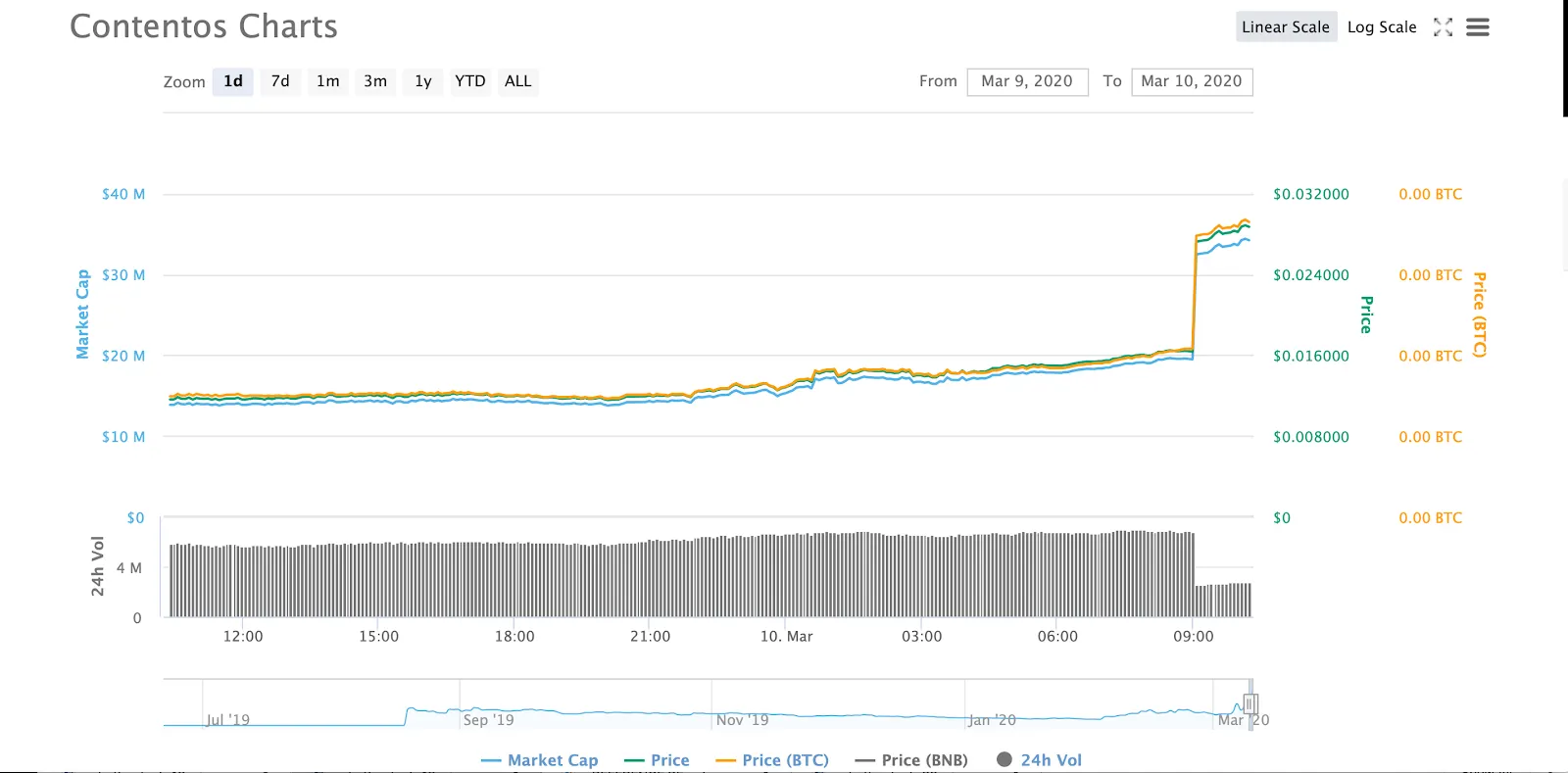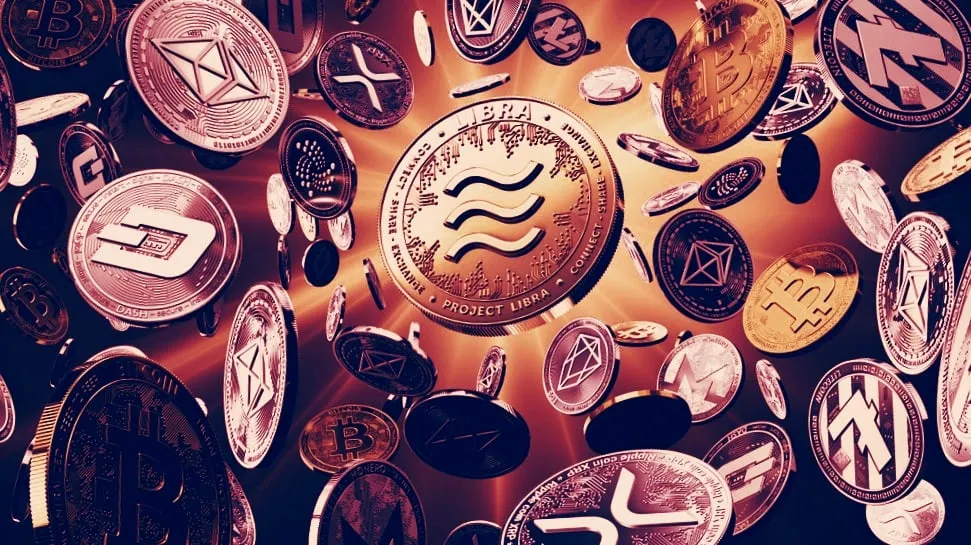In brief
- Altcoins fell with bitcoin yesterday—but, like BTC, are showing modest recovery today.
- The biggest winner of the day was Contentos's COS, which saw its price pump 158%.
- Most other coins in the top 200 say modest single-digit boosts.
We do the research, you get the alpha!
When bitcoin sneezes, altcoins get the flu. That’s probably a bad joke to make right now, but you get the point: As goes the market for bitcoin, so go the thousands of other cryptocurrencies whose fate is pegged to the mother of all blockchains. And, with BTC itself falling 10% yesterday alone, it was hardly surprising that the market cap for crypto overall dropped $40 billion from Saturday through Monday.
But now that the market appears to be recovering a bit, so are altcoins, with the vast majority of the top 100 seeing modest gains. The big winner of the day (at least in the top 200 coins on CoinMarketCap) was Contentos. The content-management system’s native token, COS, is on the Binance Coin platform and enjoys a $36 million market cap, making it the 107th most valuable coin. Today, it saw a 158% pump—to $0.03.
Who knows why! But hearty congratulations, to the Contentos whale, from the entire Decrypt team...

Elsewhere, gains were far less spectacular. We took a look at some of the better known altcoins to see how they’re doing. (The numbers next to them represent their ranking on CoinMarketCap).
Coronacoin (NCOV) #N/A
If any altcoin should be benefiting from the ravages of covid-19, it’s the Coronacoin. Yet it isn’t listed on CoinMarketCap, and it’s so low on CoinGecko, we couldn’t find a ranking associated with it. The NCOV token allows traders to bet on the new coronavirus epidemic, and it’s stumbling. In the last 24 hours the token saw a 25 percent drop in price, according to CoinGecko.
At the end of February, NCOV was $.03. It was $.0015 when I looked early today. Oddly, the value of the altcoin is supposed to increase when people die, because the networks proportionately burns coins. But all that Corona death isn’t helping the price, apparently.
Still, Sunny Kemp, a Coronacoin developer, maintains his sunny optimism. “The project is doing great,” he told Decrypt via a chat in Telegram. According to him, the alcoin was recently listed on two (obscure) exchanges—Altmarkets and Satoexchange—and the project made its first RedCross donation for $235. (The project is not as cynical as it sounds, and allocates 20 percent of its NCON supply to the non-government agencies every month.)
Fans of its gallows humor will be heartened to hear that, to boost the sihitcoin's price, the team is working on a new morbid game that will put the token to use. The game is similar to Pandemic for Android, where the player creates a pathogen in an effort to annihilate the human population.
“You create a virus and infect countries. The rate of infection and severity of the virus is dependent upon how you engineer the virus,” Kemp said in describing how it works. His team even consulted a biomedical researcher to design the game, he said.
But as to the dismal price of NCOV, he wouldn’t comment. “I cannot comment on price, we are not a security, $nCoV is a utility token,” he said.
Cardano (ADA) #12
Cardano was started by Charles Hoskinson, the ex-CEO of Ethereum. The network launched in October 2017, and in January 2018, when its native token peaked at $1.25, ADA owners were a happy bunch. The token went on to plummet to $.15 later in the year. After that, it saw a few hopeful pumps and now it’s tooting along at $.05.
To be fair, the total circulating supply of ADA is about 26 billion, so even though they aren’t worth much, there’s a hefty number of them. Hoskinson argues that based on the initial coin offering, which brought in $64 million, ADA is still good value for investors.
Still, the big question is, when will the Cardano project be decentralized? It has been centralized since its launch in September 2017. Speaking to Decrypt on the phone from his Colorado farm last night, Hoskinson said that will happen when the project transitions from Byron to its Shelley release sometime later this year. Shelly was originally slated to come out in 2018.
In defense, he said: “It’s always been a five year project from the beginning.”
Ethereum (ETH) #2
Second only to bitcoin in marketcap ETH, the native token of the Ethereum blockchain, had been on a bit of a roll lately. At least it was until mid February when ETH was at $257. Since then the price dropped slowly—until yesterday when it plunged below $192. It's back up to $201 today.
Hedera Hashgraph (HBAR) #41
Hashgraph falls into the category of “mathcoins.” Similar to other mathcoins, such as Maidsafe, Nano and IOTA (we’ll get into the latter two in a minute), the project promises a consensus mechanism that will solve all the problems of bitcoin’s energy consuming proof-of-work with clever new mathematics. And like some of the other mathcoins, Hashgraph doesn’t even use a blockchain. It uses a “hashgraph” instead.
At the same time, it still makes all the tantalising promises of cryptocurrency, including a decentralised censorship-resistant network with fast, secure and cheap transactions, but sans the headaches of PoW.
In mid-February, after Hashgraph announced that Google would be joining its high-profile governing council, the price of HBAR shot to above $.05 for the first time since the network’s launch in July 2017. Now it is sitting at below $.05 again.
Nanocoin (NANO) #58
Billed as “digital money for the real world,” Nanocoin (formerly RaiBlocks) is another mathcoin that employs all kinds of mad scientist technology. It uses “directed acyclic graph architecture” and employs its own “block-lattice architecture,” which means every individual is assigned their own blockchain.
None of that has helped the price of the NANO, which flatlined in recent months. At its highpoint in January 2018, the altcoin was worth $34. Although it hasn’t tumbled as far as others in the recent dip, it was at $.70 today.
Communications Manager Andy Johnson, shrugged off the recent change in price. “Volatility is a symptom of the nascent cryptocurrency industry,” he told Decrypt via email.
He assured us that the project is well provisioned. “Early caution ensured that we have been able to maintain a razor-sharp focus on our goals and equipped with the resources to refine the protocol and build out the surrounding ecosystem,” he said.
The project claims it is decentralized, but it also uses proof-of-stake, which means that the largest bagholders control consensus. One of them is crypto exchange Binance, which trades about 30% of the volume.
IOTA (MIOTA) #24
IOTA is proof that a network doesn’t need to be operational for an altcoin to go up in price.
Similar to Nanocoin, IOTA runs on a DAG. IOTA is not decentralized—it’s network relies on a central coordinator node, which it shut down on Feb. 12, after its Trinity wallet was hacked.
(The project didn’t say how much was lost, but IOTA founder David Sønstebø recently said he was paying back users $2 million with his own funds.)
The big task for the project is getting rid of the coordinator node—or “coordicide,” but it isn’t there yet—and hasn’t been since it launched its mainnet in July 2016.
Shutting down a network is unusual because cryptocurrencies are by nature supposed to be unstoppable, but this one apparently isn’t. The IOTA project promised it would spin the network back up Tuesday, after being turned off for nearly a month.
Despite the network literally being shut off—and a lot of other ongoing drama in the project—though it has dropped from $.03 in early February, the price of IOTA coin actually went up 4% earlier today, to nearly $.02, according to CoinMarketCap. That might lead one to the conclusion that nothing can kill a zombie altcoin.
Ripple (XRP) #3
Ah, Ripple, the platform people love to hate as being a wold in crypto's clothes. Though it has a total supply of $99 billion, most XRP is in the hands of Ripple, which currently has $54 billion in escrow. (The platform unlocks $1 billion each month and sells it.)
Our good friend XRP saw a steady decline in price last year, sinking from $0.35 in early 2019, down to $0.25. In the past few days, it dropped a few more cents to $0.21, where it currently resides—up nearly 3% in the past 24 hours.
Tether (USDT) #5
Tether is everyone’s favorite fictional trading reserve. Pegged to the U.S. dollar, USDT is the essential source of liquidity in the crypto trading markets. Every 24 hours, the entire $4.6 billion supply of tethers sloshes around 11 times. Though right now, tether is $0.99, it’s known to slide at times. Like in April 2017 when it lost its peg and dropped to $0.91. Who knows what could happen if we ever learn the real story of what’s behind those tethers.
Disclaimer
The views and opinions expressed by the author are for informational purposes only and do not constitute financial, investment, or other advice.





